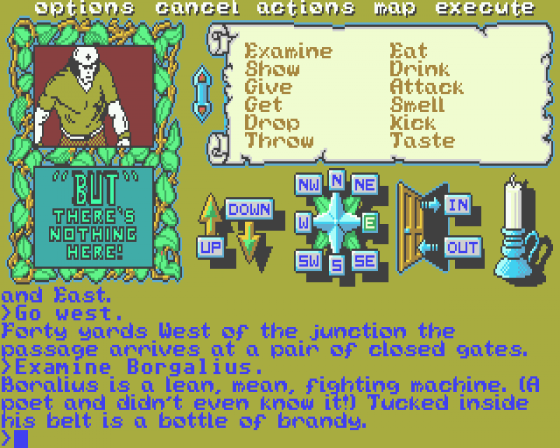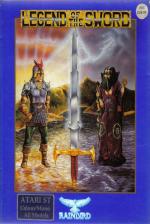
C&VG
 1st June 1988
1st June 1988
Categories: Review: Software
Author: Keith Campbell
Publisher: Rainbird
Machine: Atari ST
Published in Computer & Video Games #80
Legend Of The Sword
The appearance of The Pawn a couple of years ago, marked milestone in the history of adventure games. Since then, Rainbird has maintained its reputation for high-quality adventures, with follow-ups Guild Of Thieves and Jinxter, and Level 9's Knight Orc. Now comes Legend Of The Sword. Keith Campbell reports...
The land of Anar has been invaded by the humanoid army of the evil wizard Shuzar, and only the magic of the mystical sword and shield can protect its inhabitants. But for so long have they been guarded by the ancient Corarians, their whereabouts have vanished into folklore.
So it is that you and five other stalwarts, summoned by King Darius and confronted with the problem, volunteer to go in search of them. You are taken by boat and set down on the coast near to where the shield is believed to be hidden.

Together with your party, you make your way inland, and begin your quest. You are guided by clues, some hidden, waiting to be discovered, others to be gleaned from the locals.
As you move, a pictorial map displays your current position, and new locations are drawn in on your first visit. A very smoothly scrolling picture, it can be enlarged to full screen size by clicking on it, giving you a wider view of your surroundings.
Your band of followers stick steadfastly with you, but on the whole are a pretty useless bunch. They understand, but often fail to respond positively to many of your commands, and sulk if you ask them to give something they regard as their own property.

Usually it is a case of doing everything yourself, rather than directing your band, even to the extent of foraging for food for the whole party. If you don't keep up your strength by eating and drinking, a candle displayed on the screen slowly burns lower until it is snuffed out - and you with it!
In the search for food, valuables and food, it pays to look and examine things carefully at every point. If you are standing next to an apple tree, for example, you won't discover the fact unless you make a point of being observant.
The parser accepts complete sentences such as "Attack the humanoids with the sword", but is not up to Magnetic Scrolls or Infocom standard - no doubt it will be improved and developed in time.

On quite a few occasions it thought it had understood my command, whilst failing to grasp quite what I was getting at. "Tell the old man to wait", for example (he is imprisoned in a cell, and I had already spoken to him) brought forth: "How can you when he's inside the cell and you're outside? With your back resting against a stone wall. You sit and wait."
The program works equally well on a high-res mono monitor as on a colour monitor or TV. The mono picture is crisp and clear - far better (dare I say it?) that the black and white versions of the pictures in some other Rainbird adventures I could mention... but if you are playing in colour, there's an extra goody - you can change the paper and ink colours by altering the individual strengths of red, green and blue until you find a mix that suits you best.
With all these features plus masses of text, it is not surprising, that Legend comes on two disks. It is a big game, with many elements of role-playing built into a problem-orientated adventure. The problems may not prove too easy to solve, but the game is easy and enjoyable to play. It should establish Silicon Soft among the best of adventure producers, and maintain Rainbird's reputation for high quality, high tech adventures. The price is fairly hefty, but you get a lot for your money!
Silicon Soft

Legend Of The Sword may be new to you, but to Silicon Soft - Karl Buckingham, Colin Wooname and Eugene Messina - it's over two years old.
Silicon Soft was set in Eastbourne up under the Enterprise Allowance Scheme, as was Smart Egg Software, who produced Rigel's Revenge.
It all started when Karl, then a hospital technician, set about writing a novel around a story he had dreamed up. Before long, he had a chat with Colin about it, and as a result he decided it would make a better adventure than book. So Karl gave up his job, and the two of them, got together with Eugene, and started to create the game.

Karl himself had not played an adventure at this point, but was eventually to have a tussle with The Pawn.
"Legend has problems, but you won't find any obscure ones like having to tie a rake to a hoe with a shirt..." he mused.
When Legend was in a playable form, Karl contacted Mastertronic. "They were happy enough to accept it as it was, and see if it sold," said Karl. Not being too happy about this rather off-hand approach to the product of some four man-years work, he next approached Rainbird. Rainbird liked it, but they weren't prepared to accept an Amstrad version - they said it just wouldn't sell. They wanted 16-bit versions, they wanted changes, and they wanted another six months of work on it, in collaboration with their development team - which includes C&VG's own Paul Coppins. Then, they said, they would sell it - and sell it well."

So Colin and Karl, impressed with the backing Rainbird were preparing to put into the product, went out and bought an Atari ST. Colin had to learn how the program the machine in a couple of weeks flat, before setting about recreating the Legend system on the ST, which he wrote in C.
"I had a bit of trouble with the C compiler at first, but it didn't work out too badly," he laughed.
It has been a big investment in time, with the return still a little way off. But the system is there to use again - and is already being enhanced for the sequel, The Final Battle. This will feature more character interaction, with cameo pictures in sixteen colours, instead of the four used in Legend.











